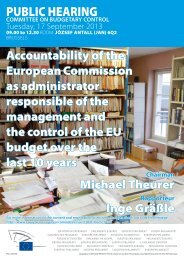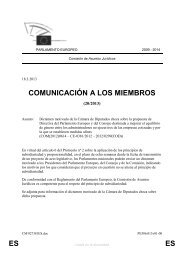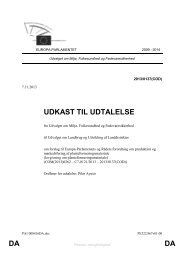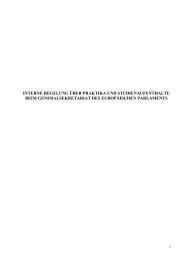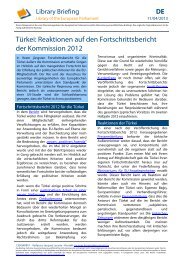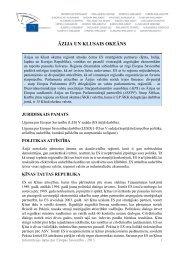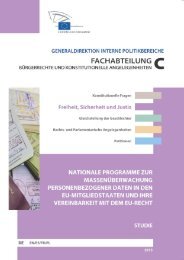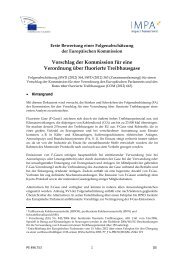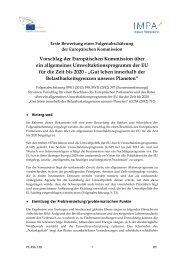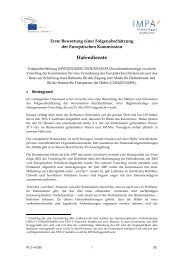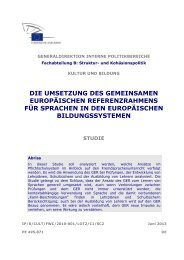Link to the study - European Parliament - Europa
Link to the study - European Parliament - Europa
Link to the study - European Parliament - Europa
You also want an ePaper? Increase the reach of your titles
YUMPU automatically turns print PDFs into web optimized ePapers that Google loves.
Policy Department D: Budgetary Affairs<br />
____________________________________________________________________________________________<br />
Selected example EDF: Chooz A<br />
Chooz is <strong>the</strong> only pressurized water reac<strong>to</strong>r currently being dismantled in France.<br />
Chooz A was <strong>the</strong> first commercial PWR built in Europe and <strong>the</strong> first PWR that is being<br />
decommissioned in France. Chooz A was commissioned by <strong>the</strong> Franco-Belgian Nuclear Energy<br />
Company of <strong>the</strong> Ardennes (SENA), a joint venture created in 1960 by EDF and a group of Belgian<br />
utilities.<br />
Construction at Chooz A started in 1961 and generation commenced in 1967.<br />
The plant was installed deep inside <strong>the</strong> bedrock of a hill in <strong>the</strong> Ardennes in<strong>to</strong> two excavated<br />
caverns where <strong>the</strong> reac<strong>to</strong>r and auxiliary installations were accommodated. In <strong>the</strong> building at <strong>the</strong><br />
<strong>to</strong>p of <strong>the</strong> hill were placed <strong>the</strong> emergency core cooling system and <strong>the</strong> ventilation stack. A steep,<br />
wide access gallery containing pipework connects those buildings <strong>to</strong> <strong>the</strong> reac<strong>to</strong>r cavern and <strong>the</strong><br />
nuclear auxiliary cavern 200 m below, 60 m from <strong>the</strong> side of <strong>the</strong> hill. A drainage system collects<br />
water percolating through <strong>the</strong> hillside in case of potential contamination.<br />
Chooz A was shut down in 1991, and <strong>the</strong> responsibility for decommissioning was transferred<br />
from SENA <strong>to</strong> EDF, which had adopted a deferred dismantling strategy at that time. By December<br />
1995, all <strong>the</strong> fuel had been removed from <strong>the</strong> facility and was dispatched <strong>to</strong> Cogema (now<br />
AREVA).<br />
Many works were started already in 1999, <strong>the</strong> circuits had been drained, industrial waste<br />
removed and <strong>the</strong> turbine hall equipment dismantled.<br />
EDF later set an ambitious target of completing decommissioning by 2016 (NEI 2010).<br />
A public enquiry was carried out in 2006, and in September 2007 a decommissioning license was<br />
issued authorizing <strong>to</strong>tal dismantling of <strong>the</strong> plant.<br />
Dismantling, clean up and demolition of nuclear buildings on <strong>the</strong> hillside, dismantling of service<br />
tunnel facilities (including <strong>the</strong> tunnel linking <strong>the</strong> cavern bot<strong>to</strong>m <strong>to</strong> <strong>the</strong> o<strong>the</strong>r facilities on <strong>the</strong> site)<br />
<strong>to</strong>ok place before 2008.<br />
The decommissioning schedule foresees three time periods (Lelong 2011, NEI 2010):<br />
2007-2008: planning work (ventilation, waste removal, etc.);<br />
2008-2016: sub-steps dismantling of nuclear auxiliary cavern (2008-2012) and dismantling of<br />
reac<strong>to</strong>r caverns (2012-2016). Until 2016, <strong>the</strong> equipment within <strong>the</strong> caverns will be<br />
dismantled except <strong>the</strong> apparatus needed <strong>to</strong> collect, moni<strong>to</strong>r and release <strong>the</strong> drained water<br />
from within <strong>the</strong> hill;<br />
As of 2016: Decontamination and regeneration of <strong>the</strong> site.<br />
The decommissioning operations are expected <strong>to</strong> be completed by 2020-2025.<br />
After <strong>the</strong> end of <strong>the</strong> aforementioned works, <strong>the</strong> plant remains under surveillance for several<br />
years. The water from inside <strong>the</strong> caverns shall be collected and tested until <strong>the</strong> radioactivity levels<br />
are reduced (remaining radioactivity from reac<strong>to</strong>r) so that <strong>the</strong> discharge can take place without<br />
tests. At <strong>the</strong> end, <strong>the</strong> components remaining in <strong>the</strong> nuclear auxiliary cavern and <strong>the</strong> waste<br />
treatment facility will be dismantled. After <strong>the</strong> finishing of <strong>the</strong>se activities - planned <strong>to</strong> be<br />
completed by 2020-2025, <strong>the</strong> underground structures will be emptied of electromechanical<br />
components and <strong>the</strong>ir civil engineering structures will be decontaminated; subsequently, <strong>the</strong><br />
caverns will be partially filled <strong>to</strong> avoid <strong>the</strong> subsidence (NEI 2010).<br />
68



